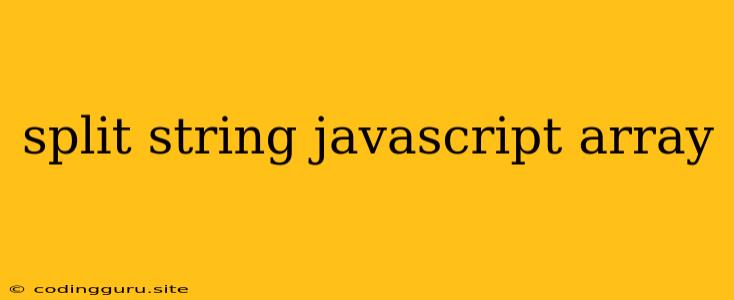Splitting Strings into Arrays in JavaScript: A Comprehensive Guide
Splitting strings into arrays is a fundamental operation in JavaScript programming, allowing you to manipulate individual parts of a string and perform various operations on them. In this guide, we'll explore the powerful split() method and its applications.
The split() Method: Your String-to-Array Converter
At its core, the split() method takes a string as input and breaks it down into an array of substrings based on a specified delimiter. The syntax is simple:
let myString = "This is a sample string";
let myArray = myString.split(" ");
console.log(myArray); // Output: ["This", "is", "a", "sample", "string"]
Here, the split() method divides the string myString by the delimiter " " (space), resulting in an array myArray containing each word as a separate element.
Delimiters: The Key to Segmentation
The delimiter you choose determines how the string is split. Here are some common delimiters and their uses:
- Space (" "): Ideal for splitting strings into individual words.
- Comma (","): Useful for separating data points in CSV (Comma Separated Values) files.
- Semicolon (";"): Commonly used in configuration files or database queries.
- Line Break ("\n"): Splits a string into lines based on newline characters.
- Custom Delimiter: You can use any character or sequence of characters as a delimiter.
Example: Splitting a URL
Let's say you have a URL like this: https://www.example.com/page/123. You can use split() to extract different parts of the URL:
let url = "https://www.example.com/page/123";
let parts = url.split("/");
console.log(parts); // Output: ["https:", "", "www.example.com", "page", "123"]
In this case, the split() method divides the URL by the delimiter "/", creating an array containing the protocol, domain, path, and any parameters.
Beyond Basic Splitting: Advanced Options
The split() method offers additional options to customize your string segmentation:
-
Limit: You can control the maximum number of elements in the resulting array by passing a second argument to
split(). This is useful when you only need a certain portion of a string.let text = "This is a long sentence."; let words = text.split(" ", 2); // Limit to two elements console.log(words); // Output: ["This", "is"] -
Empty Strings: By default,
split()includes empty strings in the resulting array if the delimiter occurs consecutively. To exclude empty strings, use thefilter()method.let data = "apple,banana,,orange"; let fruits = data.split(",").filter(item => item !== ""); console.log(fruits); // Output: ["apple", "banana", "orange"]
Real-World Applications: From Data Processing to Form Validation
The split() method has a wide range of applications in various scenarios:
- Data Processing: Parsing data from files, databases, or APIs.
- Form Validation: Checking the format and structure of user input.
- String Manipulation: Extracting specific parts of a string for further processing.
- Web Development: Creating dynamic content based on user interactions.
Combining split() with Other Methods: Unlock Powerful Solutions
When combined with other JavaScript methods like join(), map(), and reduce(), the split() method becomes a powerful tool for complex string manipulation.
-
Joining Arrays: Use
join()to combine elements of an array back into a string using a specified delimiter.let parts = ["This", "is", "a", "string"]; let joinedString = parts.join(" "); console.log(joinedString); // Output: "This is a string" -
Transforming Array Elements: Use
map()to modify each element of the array.let numbers = "1,2,3,4,5".split(",").map(Number); // Convert strings to numbers console.log(numbers); // Output: [1, 2, 3, 4, 5] -
Aggregating Array Elements: Use
reduce()to perform calculations or combine elements into a single value.let numbers = "1,2,3,4,5".split(","); let sum = numbers.reduce((acc, val) => acc + Number(val), 0); // Calculate sum of elements console.log(sum); // Output: 15
Conclusion: Mastering split() for Flexible String Management
The split() method in JavaScript is a cornerstone for efficient string manipulation. Its ability to divide strings into manageable arrays opens up a world of possibilities for data processing, form validation, and string transformations. By understanding its syntax, delimiters, and advanced options, you can effectively leverage its power to solve complex challenges in your JavaScript projects.
